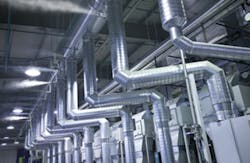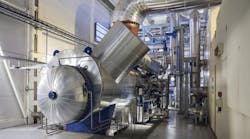To calculate energy usage and loads for a heating system, the question is: Which side of the system should we measure to provide the most accurate and encompassing measurement results?
| 7 reasons to use/not use steam as a measuring tool for energy usage
Here are some of the factors involved in measuring energy usage from the
|
The simple answer would be the steam side, since this is the heating medium providing the energy to the point-of-use location. However, when you start to look at the measurement technologies available and the difficulties presented in measuring a compressible medium, it becomes questionable if the steam side is, in fact, the most appropriate measurement location.
Due to the nature of the steam process, you are faced with a very hostile medium with extremely high temperatures. You’re also working with compressibility/density changes due to pressure/load variances, and operating ranges that have extreme variations depending on the time of the year/season. Combined with available measurement technologies, you are very limited in your ability to implement a reliable, accurate measurement solution.
READ ALSO: Ensuring Level Measurement Accuracy in Saturated Steam Applications
As a general rule, the most accurate and reliable technology available for this application is a vortex-shedding flowmeter. Vortex-shedding flowmeters use a blunt body (called a shedder bar) inserted into the flow stream to create vortices as the flow passes over/around the shedder bar. Once vortices are shed, a pickup or sensing technology detects the vortices and the rate at which they are sensed is proportion to velocity.
Depending on the sensing technology employed, any particular vortex meter will have a maximum and minimum velocity range. These ranges will vary with the technology, but as a rule of thumb, vortex meters are very linear and repeatable to +/-1.0 percent of rate or reading with a typical ideal meter turndown range of 20-to-1.
Also, keep in mind that at the meter’s low velocity point — which is Reynolds number dependent on where the medium (steam) goes from transitional to laminar flow — the shedder bar no longer sheds vortices. This means the meter has nothing to measure and, therefore, goes to zero. That is, unless a fixed output is configured into the output circuit — which is more common than not in some devices — to make the meter read some value. To make the problem worse, depending on how the meter was initially sized for the application (oversized in most cases), 15 percent to 50-plus percent of the actual load or flow could still be passing by the meter, while the meter has no vortices to enable flow measurement.
Cleve Nyberg has 25 years of process control experience with a strong background in both analytical and flow instrumentation. He worked in the field as an application consultant, product sales manager, and regional sales manager for two international instrumentation companies prior to joining Cadillac Meter, also known as Central Station Steam Company.


